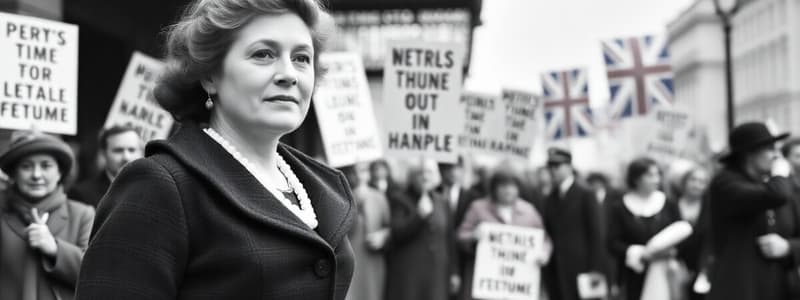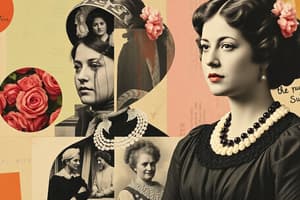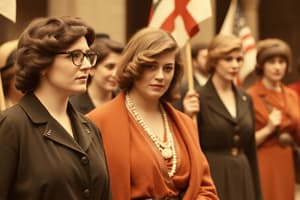Podcast
Questions and Answers
Lucy Burns' first arrest occurred in the United States.
Lucy Burns' first arrest occurred in the United States.
False (B)
Lucy Burns' parents were both from Ireland.
Lucy Burns' parents were both from Ireland.
False (B)
Lucy attended more than five universities in her lifetime.
Lucy attended more than five universities in her lifetime.
True (A)
Lucy admired the British suffragists' actions because they were non-violent protests.
Lucy admired the British suffragists' actions because they were non-violent protests.
Lucy believed American women were too slow to adopt the new trends and activism of the era.
Lucy believed American women were too slow to adopt the new trends and activism of the era.
Lucy Burns was arrested for the first time in 1909.
Lucy Burns was arrested for the first time in 1909.
Alice Paul was arrested at the same time as Lucy Burns.
Alice Paul was arrested at the same time as Lucy Burns.
The motto of the British suffragists Lucy admired was "Words, not deeds."
The motto of the British suffragists Lucy admired was "Words, not deeds."
Lucy was frequently celebrated by NAWSA for her radical approaches to suffrage.
Lucy was frequently celebrated by NAWSA for her radical approaches to suffrage.
The suffrage parade organized by Lucy and Alice took place on March 3, 1912.
The suffrage parade organized by Lucy and Alice took place on March 3, 1912.
Lucy was the first picketer to be arrested during the protests outside the White House.
Lucy was the first picketer to be arrested during the protests outside the White House.
During the suffrage parade, police intervened to protect the women from the mobs.
During the suffrage parade, police intervened to protect the women from the mobs.
The banner unfurled by Lucy and other women at Wilson's address read 'What Will You Do for Woman Suffrage?'
The banner unfurled by Lucy and other women at Wilson's address read 'What Will You Do for Woman Suffrage?'
Lucy spent less time in prison than any other suffragist involved in the movement.
Lucy spent less time in prison than any other suffragist involved in the movement.
The picketers referred to Wilson as 'Kaiser Wilson' to express their frustration with his stance on suffrage.
The picketers referred to Wilson as 'Kaiser Wilson' to express their frustration with his stance on suffrage.
Three hundred women were treated for injuries during the suffrage parade.
Three hundred women were treated for injuries during the suffrage parade.
The suffragists were taken to Occoquan Workhouse on November 14-15, 1917.
The suffragists were taken to Occoquan Workhouse on November 14-15, 1917.
Lucy was only jailed twice during her activism for women's suffrage.
Lucy was only jailed twice during her activism for women's suffrage.
The guards at Occoquan Workhouse treated the suffragists with respect and dignity.
The guards at Occoquan Workhouse treated the suffragists with respect and dignity.
Lucy started a hunger strike to gain political prisoner status for the suffragists.
Lucy started a hunger strike to gain political prisoner status for the suffragists.
The suffragists burned copies of Wilson's speeches as a form of protest.
The suffragists burned copies of Wilson's speeches as a form of protest.
Lucy was awarded the highest honor for her role in the suffrage movement before retiring.
Lucy was awarded the highest honor for her role in the suffrage movement before retiring.
The suffragists were attacked by police while they were peacefully picketing.
The suffragists were attacked by police while they were peacefully picketing.
Alice Paul was the one who led the suffragists during their protests.
Alice Paul was the one who led the suffragists during their protests.
Flashcards
Who was Lucy Burns?
Who was Lucy Burns?
Lucy Burns was an American suffragist who fought for women's right to vote in the early 20th century.
What group was Lucy Burns associated with?
What group was Lucy Burns associated with?
She was a prominent member of the National Woman's Party, a group advocating for women's suffrage through direct action and protests.
Why did Lucy Burns become involved in suffrage activism?
Why did Lucy Burns become involved in suffrage activism?
While studying at Oxford, she attended a suffrage meeting led by British activist Emmeline Pankhurst, who inspired her to embrace a more active approach to the cause.
What did Lucy Burns do to fight for women's suffrage?
What did Lucy Burns do to fight for women's suffrage?
Signup and view all the flashcards
What was the 'Deeds, not words' philosophy?
What was the 'Deeds, not words' philosophy?
Signup and view all the flashcards
What was Lucy Burns' experience with prison?
What was Lucy Burns' experience with prison?
Signup and view all the flashcards
What does the collage represent?
What does the collage represent?
Signup and view all the flashcards
What makes Lucy Burns significant?
What makes Lucy Burns significant?
Signup and view all the flashcards
Votes for Women!
Votes for Women!
Signup and view all the flashcards
Alice Paul
Alice Paul
Signup and view all the flashcards
Congressional Union for Woman Suffrage
Congressional Union for Woman Suffrage
Signup and view all the flashcards
1913 Suffrage Parade
1913 Suffrage Parade
Signup and view all the flashcards
Silent Sentinels
Silent Sentinels
Signup and view all the flashcards
President Woodrow Wilson
President Woodrow Wilson
Signup and view all the flashcards
The 'Kaiser Wilson' Banners
The 'Kaiser Wilson' Banners
Signup and view all the flashcards
19th Amendment
19th Amendment
Signup and view all the flashcards
What was the Night of Terror?
What was the Night of Terror?
Signup and view all the flashcards
How did the Night of Terror impact public opinion?
How did the Night of Terror impact public opinion?
Signup and view all the flashcards
What were the conditions in the Occoquan Workhouse?
What were the conditions in the Occoquan Workhouse?
Signup and view all the flashcards
What did Lucy Burns do to protest her treatment?
What did Lucy Burns do to protest her treatment?
Signup and view all the flashcards
What challenges did suffragists face in prison?
What challenges did suffragists face in prison?
Signup and view all the flashcards
Why did the suffragists burn an effigy of President Wilson?
Why did the suffragists burn an effigy of President Wilson?
Signup and view all the flashcards
What was the ultimate outcome of the suffragists' efforts?
What was the ultimate outcome of the suffragists' efforts?
Signup and view all the flashcards
Study Notes
Lucy Burns: Suffragette Activist
- Lucy Burns was born on July 28, 1879, and died on December 22, 1966.
- She was an American suffragette.
- Arrested in London in 1909, along with Alice Paul, for protesting with British suffragettes.
- Arrested and jailed multiple times for suffrage activities.
- Imprisoned in Occoquan Workhouse in Virginia for a period of time amid the suffrage movement, 1917.
- Involved in hunger strikes and militant protests during the suffrage movement.
- Argued for "Deeds, not words" in the suffrage movement.
- Developed and led militant tactics.
- Organized and participated in a suffrage parade in Washington D.C.
- Helped to form the Congressional Union for Woman Suffrage.
- Had considerable influence in the suffrage movement, both domestically and internationally.
- A notable figure in the fight for women's suffrage in the United States.
Early Life and Education
- Little is known about her childhood.
- Born in Brooklyn, to Irish-American parents in Park Slope.
- Educated at Vassar, Yale, Columbia, Oxford and two German universities, showcasing her dedication to academics.
- Demonstrated an early aptitude for learning and seizing educational opportunities.
Suffrage Activism
- Worked with British suffragists in London.
- Arrested and imprisoned in England.
- Organized and led various protests alongside Alice Paul.
- Became part of the National American Woman Suffrage Association (NAWSA).
- Took part in a 1913 suffrage parade in Washington D.C., which was met with opposition.
- Played a key role in the suffrage movement in the United States.
- Faced opposition and criticism for increasingly radical tactics.
- Arrested several times, including for civil disobedience.
- Remained a key figure in the suffrage movement.
Later Life and Legacy
- Focused on training younger generations of suffragists after gaining suffrage.
- Remained engaged in the women's rights movement even after the passage of the 19th Amendment.
- Died in 1966 while still active in her activism.
Studying That Suits You
Use AI to generate personalized quizzes and flashcards to suit your learning preferences.




